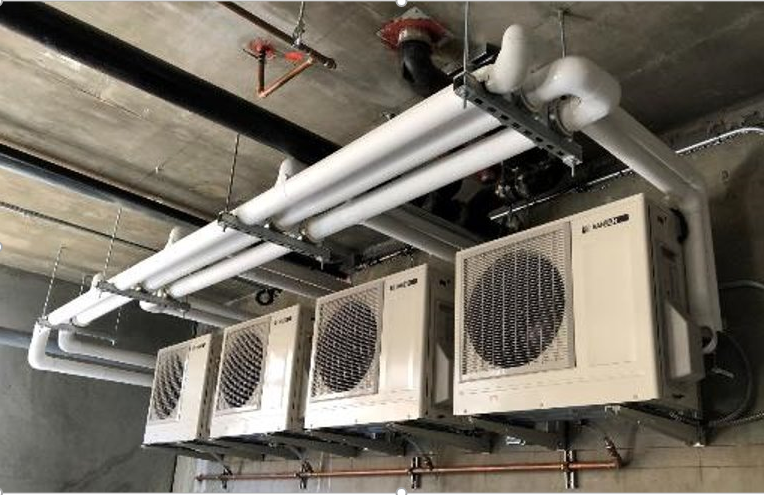Using SANCO2 in Multi-Family Buildings to Get off Gas
/SANCO2 Can Be Used to Design High-Efficiency, Carbon Free DHW Systems for Multi-Family Applications
Multifamily domestic hot water design need not be a complicated or expensive array of water heaters for each residence. A tidy and efficient design can be provided by a centralized heat pump system. To best achieve this, enter the SANCO2 hot water heat pump. These two-component systems can be used as building blocks of a much larger central DHW plant. The SANCO2 also boasts increased efficiency over electric heating element tanks, and lower global warming potential than natural gas and even other heat pump water heaters. Using a centralized DHW plant design, rather than individual units for each residence, the cost is spread out while still providing steady hot water to residents. Consider meeting new energy codes with a centralized hot water heat pump system that provides higher energy efficiency and a carbon free heating system.
Use Multiple Storage Tanks to Create a Centralized DHW Plant
A shift from gas fired DHW plants is a shift to a storage strategy that matches the heat pumps recovery rates. With SANCO2, multiple tanks can be ganged together to meet the peak demand requirements of the building. Choosing the size of these storage tanks is based on the number of dwellings and the habits of the occupants. Storage tanks can remain indoors in a centralized location, allowing for quick and easy maintenance.
Unlike traditional gas or electric water heaters, SANCO2 tanks have no heating elements, and are insulated extremely well. Suitable tank sizes range from 43 gallons into the thousands. This design relies on a stratified tank, which gives the single pass heat pump what it wants: A lift from the city cold water temp to 150F (70c) in one pass. The high temperature water flows into the primary storage system where it is held until drawn.
Primary storage designs rely on stratification. The design can use one big tank with the cold water at the bottom, or multiple tanks piped in series where the last tank holds the cold layer and the front tank receives the heat pump output of high temperature water. The piping design places the cold water in the bottom of the single large, or series of tanks. The heat pump output is piped into the top of the single large tank, or the front tank of the series. The DHW output to the building is also piped from the top, or the front tank.
Four 119 gal tanks for a total storage of 476 gallons. If the heat pump storage temp is 80°C this is equivalent to 835 gallons at 50°C.
When there is a DHW draw, high temp water is pulled from the front and is replaced by cold water at the bottom of the single, or series. When there is a call to warm the storage, cold water is pulled from the bottom, or back of the tank series, run through and lifted in the heat pump, and then piped into the top or front where it is pulled backwards by the volume leaving the bottom or back. This cycle keeps going until the high temperature water is pulled all the way to the bottom of the single, or back, of the tank series. When the high temp water fills the entire storage volume, and there is no more cold water stored, the heat pump sees this incoming high temp water and knows to shut off as the entire volume is now full of very hot water.
Compression Heat Exchange Pumps
Multiple SANCO2 Units Ganged together for multi-family DHW.
Working in tandem with the stratified tanks is the SANCO2 heat pump. Being an air source heat pump (it extracts its heat from the air), the SANCO2 can work in cold and temperate climates alike. Importantly, by splitting the tank and heat pump, the system uses outdoor air as the source of energy. This provides greater building efficiency over a conventional heat pump water heater that ‘scavenges’ heat from the indoor air. The conventional system steals energy from the indoor air, thus increasing the building space heating demand.
Another differing factor to the SANCO2 strategy is the higher water temperatures achieved. These heat pumps can be set to produce water at temperatures of up to 80°C (175°F), and by storing water at a higher temperature and mixing with cool supply water to normal use temp, about 120F (50°C), it effectively increases the equivalent conventional tank size of the system, which means more, consistent hot water per dwelling.
In a large multifamily application, several heat pumps are able to be ganged together to meet the systems recovery rate demands. Each heat pump can be calculated to provide ~16,000 btu/hr. or 25 GPH of mixed water. The more heat pumps, the faster the recovery of stored DHW will be. Notably, the number of heat pumps needed is always much less than one heat pump per dwelling unit. If the building load calls for 800 gallons of storage to serve the peak load of 60 apartments, eight heat pumps will recover the 800 gallons in about four hours. Not all building load patterns require such fast recovery, depending on the building use, the recovery could be purposely lengthened into 5-1/2 hours by reducing the number of heat pumps to six, or closer to seven hours with just five heat pumps. The reasons to reduce heat pumps and recover the system over longer periods aren’t necessarily just capital costs. They are also space constraints, matching recovery to long periods of available renewables, or Utility pricing based on time of use incentives. With the ability to incrementally gang these ultra-efficient heat pumps into a single working plant, the designs can now consider multiple factors of the building use, special constraints and utility programs.
Increased Efficiency with CO2
While conventional heat pumps compress hydrofluorocarbons to conduct heat exchange, SANCO2 pumps use carbon dioxide as the refrigerant, hence the CO2 part of the name. The CO2 is compressed under much higher pressures than would be used for HFCs, this allows the system to net up to 500% efficiency, or up to 150% better COP than traditional heat pumps.
The Coefficient of Performance (COP) is a ratio of electricity put in, compared to how much heat is put out. For this unit it can be as high as COP 5 (500% efficient) but is dependent on the outdoor ambient temperature, inlet water temperature, and target storage water temperature. Impressively, the unit is still 300% efficient at outdoor ambient temperatures of -5°C (23°F). Compare this with electric resistance water heaters with a static COP of 1 (100%) and gas boilers that have a COP of <0.90 (<90%).
The effects of COP are most evident in the relationship between electric input energy and hot water output energy. Each SANCO2 heat pump is designed to output 4.5kW of energy (~16,000 btus/hr.) in the form of hot water. The required input energy is dependent on ambient temperature, again performing most efficiently (COP ~5) at higher temperatures (~40°C), but still showing ample performance (COP ~2) at ambient outdoor temperatures down to -15°C. Furthermore, the SANCO2 system is always able to make 70°C water at all outside air temperatures, ensuring lasting hot water in even the coldest climates.
CO2’s Negligible Global Warming Potential Protects the Environment
GRAPHIC COURTESY OF SANden
Traditional refrigerants, R410A and R134A, are hydrofluorocarbons that are commonly used in heat pumps. These refrigerants have a large draw back regarding global warming. During normal operation and maintenance, this gas can escape the system through diffusion, and is vented into the atmosphere.
Hydrofluorocarbons are far worse for the environment than CO2. The global warming potential (GWP) is a measure of how much a given mass of greenhouse gas is estimated to contribute to global warming. It is a relative scale which compares the gas in question to that of the same mass of carbon dioxide. Therefore, CO2 always has a GWP of 1. Conventionally used R134A and R410A have a GWP of 1430 and 2088, respectively. This means releasing one pound of R410A is equivalent to releasing 2088 lbs. of CO2 into the atmosphere. Why not just use one pound of CO2 instead? Furthermore, the SANCO2 uses just 22 oz of CO2, and is factory sealed, negating the need for on-site filling or maintenance.
Because the refrigerant is contained in the heat pump, the only plumbing between tank and heat pump will be the water line. This greatly simplifies installation and plumbing routes, while also minimizing building penetrations. Since there is no refrigerant to charge or lines to worry about, installation can be performed by any licensed plumber. To reap even further benefits from the system, it is possible to combine DHW needs and radiant heating output in one convenient system. Keep SANCO2 in mind next time a job requires a versatile, scalable, and efficient DHW solution.
One-on-One Online Consultation For Sanden SANCO2 Multi-family System Design Available from Small Planet Supply
For more information, a one-one consultation can be booked through the WaterDrop website To size a system, you should have the following information ready:
Number of units
Number of stories
Number of bathrooms
Average occupancy per unit
Number of laundry machines (either each unit or shared)
Flow rates of shower heads
Duration of anticipated peak demand
Mechanical plans, if applicable
At Small Planet Supply, we can help you put together an energy-efficient water heating system fit for your multi-family project needs. If you’ve got a multi-family or single family project coming up soon, let us help you design with the planet in mind.
More Resources:
WaterDrop Systems Brochure
Small Planet Supply has also started manufacturing WaterDrop, a pre-packaged DHW skids, for multi-family and commercial applications. You can read more about these systems by clicking here










